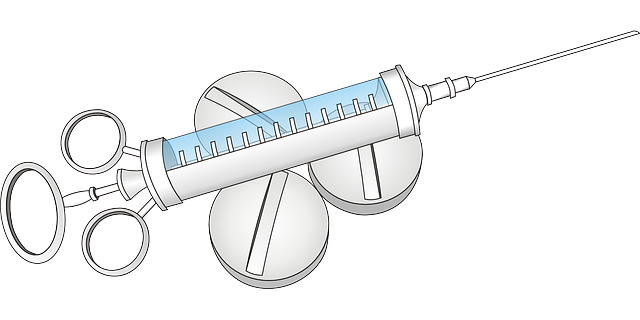The pancreas, a vital organ producing hormones and enzymes for digestion, is disrupted in diabetes. Semaglutide medication, mimicking natural intestinal hormones, enhances insulin secretion and suppresses glucagon release, revolutionizing glucose control. Its dual actions stimulate beta-cell function, improve glycemic control, and offer potential therapy for pancreatic cell dysfunctions. Clinical studies show semaglutide's positive effects on pancreatic health, with reduced HbA1c levels and improved islet functionality. Side effects like gastrointestinal issues require monitoring, but many patients report improved health and quality of life. Future research focuses on personalized strategies to enhance beta-cell function, building on semaglutide's success in treating type 2 diabetes.
“Unraveling the secrets of pancreatic cell function and its intricate balance is key to understanding metabolic health. This article delves into the groundbreaking role of semaglutide, a revolutionary medication, in transforming pancreatic well-being. By exploring its mechanisms, we uncover how semaglutide restores disrupted functions, offering more than just blood sugar regulation. From clinical trials to patient testimonials, this comprehensive guide illuminates the impact of semaglutide on pancreatic health, providing insights for both medical professionals and those seeking improved metabolic control.”
Understanding Pancreatic Cell Function and Its Disruptions

The pancreas is a vital organ that plays a crucial role in maintaining overall health. It houses specialized cells responsible for producing essential hormones and enzymes that regulate digestion and metabolism. Pancreatic cell function involves a complex interplay of secreting insulin, which facilitates glucose uptake by cells, and other hormones to control various metabolic processes. Disruptions in this intricate system can lead to significant health issues, particularly diabetes.
Semaglutide medication has emerged as a game-changer in managing these disruptions. It is a synthetic form of a hormone that mimics the effects of natural intestinal hormones, enhancing insulin secretion and suppressing glucagon release. This dual action helps improve glycemic control, making it an effective treatment for type 2 diabetes. By understanding the fundamental functions of pancreatic cells and the impact of their disruptions, healthcare professionals can better appreciate the potential benefits of semaglutide medication in treating metabolic disorders.
Introduction to Semaglutide: A Revolutionary Medication

Semaglutide is a groundbreaking medication that has been making waves in diabetes management and, more recently, in the field of pancreatic cell health. This innovative drug, primarily known for its role in treating type 2 diabetes, has shown remarkable potential to enhance pancreatic beta-cell function. By mimicking the action of natural hormones, semaglutide revolutionizes glucose control, offering a promising new avenue for improving insulin production and secretion.
The medication’s mechanism involves activating receptors that stimulate insulin release and suppress glucagon secretion, resulting in better blood sugar regulation. This dual action not only benefits diabetics but also holds therapeutic potential for those at risk of developing diabetes or with pancreatic cell dysfunctions. With its ability to improve insulin sensitivity and promote beta-cell health, semaglutide medication is poised to become a game-changer in diabetes care and potentially revolutionize the way we approach pancreatic cell function.
The Mechanisms Behind Semaglutide's Effectiveness

Semaglutide, a medication designed to mimic a natural hormone, has shown remarkable effectiveness in improving pancreatic cell function. Its primary mechanism lies in its ability to stimulate insulin secretion and suppress glucagon release, leading to better blood sugar control. By mimicking the actions of GLP-1, a hormone produced by L cells in the intestine, semaglutide activates specific receptors in the pancreas, prompting the beta cells to produce more insulin in response to rising blood glucose levels.
Moreover, semaglutide slows gastric emptying, which gives the body more time to process and absorb nutrients. This dual action not only enhances glycemic control but also contributes to weight management, as it increases feelings of fullness and reduces appetite. The medication’s impact on pancreatic cells is particularly beneficial for individuals with type 2 diabetes, offering a novel approach to managing the condition alongside traditional treatments.
Clinical Studies: Proving Its Impact on Pancreatic Health

Clinical studies have played a pivotal role in showcasing the positive impact of semaglutide medication on pancreatic health. These research endeavors have demonstrated that semaglutide, an innovative glucose-lowering drug, can significantly enhance the function of pancreatic cells, particularly in individuals with type 2 diabetes. The findings from these studies reveal that regular administration of semaglutide improves insulin secretion and boosts beta cell health, which is crucial for maintaining optimal blood sugar levels.
Through controlled trials, scientists have observed remarkable results, including reduced HbA1c levels (a marker of long-term blood glucose control) and improved glycemic management. Moreover, these studies have indicated that semaglutide may even protect against pancreatic cell death, a common complication in diabetes. Such clinical evidence underscores the potential of this medication as a game-changer in pancreatic care, offering hope for improved quality of life for those living with chronic diabetes.
Benefits Beyond Blood Sugar Regulation

The benefits of semaglutide medication extend far beyond just blood sugar regulation, offering a promising avenue for comprehensive pancreatic cell function improvement. By mimicking the effects of the natural hormone GLP-1, semaglutide stimulates insulin production and suppresses glucagon secretion, leading to more stable blood sugar levels. However, its impact doesn’t stop there. Research suggests that this medication can enhance cellular responses, promoting not only beta-cell survival but also improving overall pancreatic islet function.
This multi-faceted approach addresses several aspects of metabolic health. It not only reduces the risk of hypoglycemia but also mitigates the progression of type 2 diabetes complications by improving insulin sensitivity and reducing inflammation. The positive effects on pancreatic cells could potentially delay or even prevent the need for insulin therapy, offering a significant quality of life improvement for patients.
Potential Side Effects and Precautions

While semaglutide medication has shown significant promise in improving pancreatic cell function, it’s crucial to be aware of potential side effects. Some individuals may experience gastrointestinal issues such as nausea, vomiting, or diarrhea, especially during the initial stages of treatment. These symptoms are usually temporary and tend to subside as your body adjusts to the medication.
It’s important to follow your healthcare provider’s advice regarding dosage and timing of meals. Regular monitoring by your doctor is essential to ensure safe and effective use of semaglutide. They may adjust the dosage based on your response to the treatment, and it’s vital to report any concerning symptoms or changes in your health promptly.
Administration and Dosage Guidelines

The administration of semaglutide medication is typically via subcutaneous injection, offering a convenient and effective delivery method. The dosage varies depending on individual patient needs and medical guidance. For pancreatic cell function improvement, healthcare professionals often prescribe a starting dose of 0.5 mg or 1.0 mg once weekly. It’s crucial to adhere to the prescribed schedule and not miss doses. Over time, as the body adjusts, dosages may be adjusted up or down by the treating physician based on blood sugar levels and overall pancreatic health indicators.
It is essential to follow the instructions provided with your prescription for proper administration. This includes using the correct injection technique and rotating injection sites to prevent local tissue irritation. Patient education plays a vital role in ensuring successful management of semaglutide therapy, empowering individuals to actively participate in their diabetes or pancreatic health care.
Real-Life Success Stories: Patient Testimonials

Many patients with type 2 diabetes have shared inspiring stories about their improved health and quality of life after incorporating semaglutide medication into their treatment plans. These real-life success stories highlight the transformative power of this innovative therapy.
Semaglutide has made a significant difference for numerous individuals, helping them achieve better blood sugar control, reduce weight, and even eliminate the need for insulin injections in some cases. Testimonials often emphasize the medication’s ease of use—a simple injection once weekly—and its positive impact on overall well-being. Patients report feeling more energetic, confident, and excited about their future prospects, all thanks to semaglutide’s effective support of pancreatic cell function.
Future Perspectives and Ongoing Research

The future of pancreatic cell function research looks promising, with a growing focus on novel therapeutic strategies. One prominent compound gaining significant attention is semaglutide medication, an analog of the gut hormone GLP-1. Ongoing studies explore its potential to not only improve insulin secretion but also protect and regenerate pancreatic beta cells, offering a multi-faceted approach to diabetes management.
Research in this area continues to unearth insights into the complex interplay between various cellular signaling pathways, inflammation, and oxidative stress within the pancreas. These investigations aim to identify new molecular targets for therapeutic intervention, building upon the successes of existing treatments like semaglutide. By expanding our understanding of pancreatic biology and disease mechanisms, scientists strive to develop more effective and personalized strategies to enhance beta-cell function and ultimately improve glycemic control.
